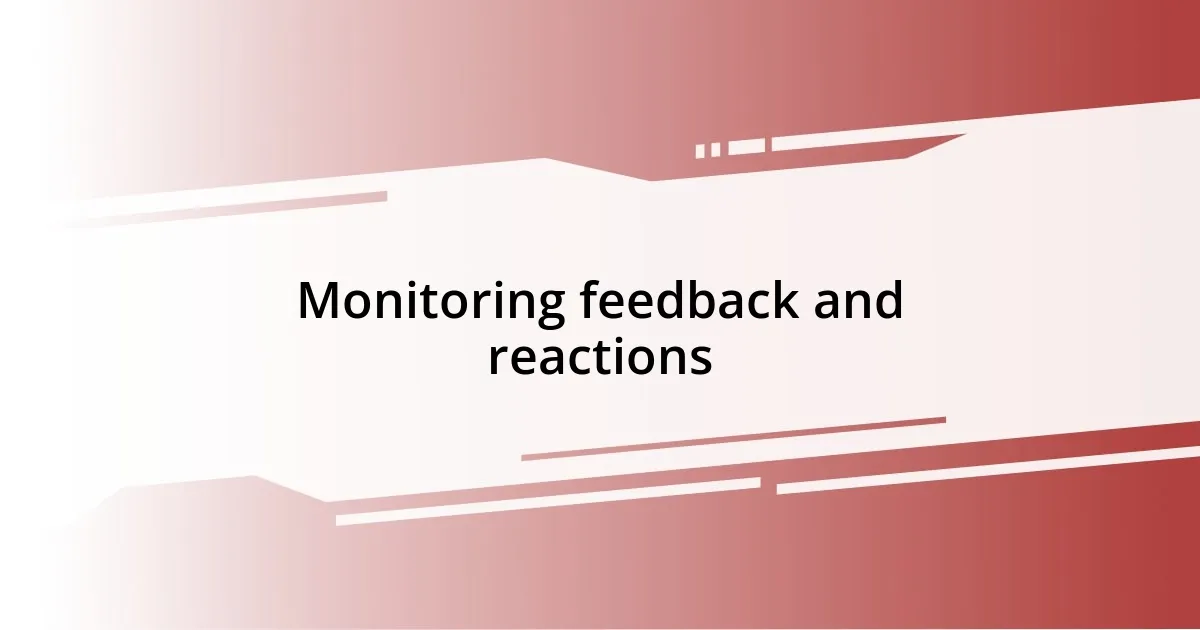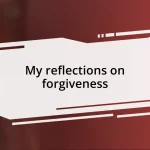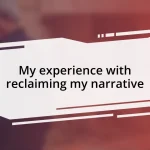Key takeaways:
- Sharing personal stories fosters connection, empathy, and community while helping others feel less alone.
- Choosing the right platform for sharing is essential, as it affects audience engagement and privacy.
- Setting appropriate privacy and security settings is crucial for comfort and safety when sharing online.
- Monitoring audience feedback informs how to adjust storytelling for deeper connections and respect for sensitivities.

Understanding the need for sharing
Sharing our stories fulfills a fundamental human need to connect with others. I remember a time when I hesitated to open up about a struggle I faced. Once I finally did share, I was surprised to find that others had been through similar experiences. Isn’t it comforting to know we’re not alone in our challenges?
When we share, we also invite empathy and understanding into our lives. I’ve found that even the simplest anecdotes can bridge gaps between people, fostering a sense of community. For example, during a tough time, my vulnerability sparked discussions that deepened my relationships. Have you ever noticed how sharing your story can lighten your emotional load?
Moreover, sharing can spark impact. Think about how a personal story can inspire others to face their own fears or seek help. I recall a colleague who spoke openly about her mental health journey, and it inspired our team to cultivate a more supportive environment. Doesn’t it feel powerful to know that your experience might illuminate a path for someone else?

Choosing the right platform
Choosing the right platform for sharing your story is crucial. Different platforms serve diverse purposes and audiences, and your choice can shape how your message is received. I once shared a personal experience on a community forum and was amazed by the supportive feedback. However, when I tried to share the same story on a more public social media platform, the response was mixed. It made me realize that where you share your story can significantly influence its impact.
Consider the following factors when choosing your platform:
- Audience: Who do you want to reach? A supportive community or a broader public audience?
- Privacy: How much of your personal life are you comfortable exposing? Some platforms offer privacy settings, while others may not.
- Content Type: Are you sharing text, videos, or images? Certain platforms are better suited for specific types of content.
- Engagement: How do you want your audience to interact? A blog allows for detailed discussions, while social media encourages quick comments.
Ultimately, I believe the right choice aligns with your comfort level and the type of connection you seek. If I could go back, I’d have chosen more carefully for different scenarios to ensure my story found its best home.

Setting privacy and security settings
Setting privacy and security settings is vital when sharing personal stories online. I’ve learned that taking a few moments to adjust these settings can save you from potential discomfort later. For instance, the first time I shared something deeply personal, I didn’t realize my posts were visible to everyone. The rush of openness faded quickly as I considered who might be reading it. Since then, I have actively adjusted settings on various platforms, ensuring I’m comfortable with my audience.
It’s important to understand the nuances of privacy settings. Many platforms allow you to customize who sees your posts—be it friends, family, or a select group. I recall struggling with one platform that had convoluted privacy options; it took some time, but eventually, I discovered the right configuration that gave me peace of mind. This experience reinforced my belief that being proactive about security can make sharing feel safe and empowering.
Here’s a quick comparison of how different platforms approach privacy and security settings:
| Platform | Privacy Settings |
|---|---|
| Highly customizable—can limit post visibility to specific audiences. | |
| Public by default, but can switch to private account for limited access. | |
| Offers private accounts and controls over who can comment. | |
| More professional—allows control over profile visibility and connection requests. |

Crafting your story effectively
Crafting your story effectively means choosing your words with intention. I remember the first time I shared a difficult chapter of my life. I spent hours refining it, wanting to convey not just the facts but the emotions behind them. When you focus on honesty and clarity, you allow your audience to connect with your experience. What emotions do you want to evoke? If I could give one piece of advice, it would be to always write from a place of authenticity—readers can sense when you’re being genuine.
Another important aspect is the structure of your story. Using a clear beginning, middle, and end can guide your audience through your journey. Recently, I experimented with this format while sharing a moment of failure at work. By leading with the struggle and then highlighting the lessons learned, the feedback I received was overwhelmingly positive. It’s amazing how a well-structured narrative can turn what might seem like a simple experience into something impactful and relatable.
Finally, consider the takeaway you want your audience to have. Reflecting on personal experiences, I find it helpful to ask myself: what message do I want to impart? One time, after sharing a story about overcoming anxiety, I was surprised by how many people reached out, sharing their own battles. It made me realize that a thoughtfully crafted story can inspire connection and encouragement. When you share your narrative, aim for a resonance that lingers long after the last word is read.

Engaging your audience responsibly
Engaging your audience responsibly means being mindful of the impact your words can have. I remember one instance where I opened up about my struggles with self-doubt in front of a large group. While I hoped it would foster discussion, I realized not everyone was ready to share their vulnerabilities. Reflecting on that moment, I learned it’s crucial to create a safe space for dialogue, ensuring your audience feels comfortable to engage back.
In my experience, inviting feedback can significantly enhance your message. After sharing a piece on overcoming obstacles, I asked my readers what challenges they faced, and the responses flooded in. It felt like a community had formed around our shared stories. With such interactions, it’s clear that responsible engagement isn’t just about sharing; it’s about listening and validating others’ experiences too.
I’ve found that setting boundaries is equally vital. When I talked about a sensitive subject, I was careful to share only what I was ready to discuss publicly. It was a liberating moment for me, but it also encouraged others to share while respecting their limits. Are you comfortable with the content you’re sharing? I often remind myself that it’s okay to hold back certain details if it means protecting myself or others involved. Balancing openness with responsibility is a dance that can lead to more meaningful connections.

Monitoring feedback and reactions
Monitoring feedback and reactions is a critical step in the storytelling process. I recall the time I shared a heartfelt story about loss. Initially, I was anxious about how people would respond. However, as comments and messages started pouring in, I realized the power of vulnerability. Watching others relate to my experience allowed me to prioritize the emotional pulse of my audience, validating that my story had evoked genuine connections.
Feedback isn’t just about praise or criticism; it’s a window into how your message resonates. After sharing a personal triumph, I was struck by a message from someone who had faced the same struggle but hadn’t found their resolution yet. That exchange reminded me that our stories can serve as beacons for others. It makes me think—how much are you learning from the reactions to your narratives? I’ve learned to embrace the nuance in feedback, which often leads to deeper insights about my storytelling.
Paying close attention to reactions gives you the chance to adjust your approach in real-time. Recently, I shared a piece where I noticed some discomfort among readers—many remained silent instead of engaging. This prompted me to reflect. Was I pushing too hard on sensitive topics? I took the time to revise my approach, focusing on creating a softer entry. The result was stunning: a rejuvenated dialogue and a community that felt listened to. Our stories have power, and those reactions can guide us to shape them in a way that’s not just impactful, but respectful. Wouldn’t you agree that awareness can transform how we connect with others through our narratives?

Learning from the experience
Learning from my experiences has been a transformative journey. I distinctly recall a time I shared a candid story about my struggle with anxiety during a workshop. The immediate responses from participants were overwhelming; many expressed relief and gratitude that I had voiced a topic often shrouded in silence. It taught me that authenticity not only fosters connection but also invites others to reflect on their own experiences. Have you ever witnessed how sharing a piece of yourself can reveal the hidden struggles of others?
In another instance, I tried opening up about a past relationship that had deeply impacted me. While I thought I was ready for the conversation, some attendees seemed emotionally charged. This feedback allowed me to recognize the importance of timing and emotional readiness in sharing sensitive stories. I learned that, sometimes, stepping back and gauging the room can illuminate unspoken boundaries. Would you consider pausing to assess your audience before diving into a vulnerable topic?
Lastly, reflecting on my storytelling journey, I remember when I hesitated to share a particularly personal chapter about my mental health. I kept asking myself, “What if I overwhelm them?” After finally sharing, I was amazed by the waves of support that followed. It was a clear reminder that my hesitations were often assumptions. Learning to trust my voice while being mindful of my audience’s emotional landscape has been crucial. Isn’t it fascinating how vulnerability can not only free us but also unite us in our shared human experience?














